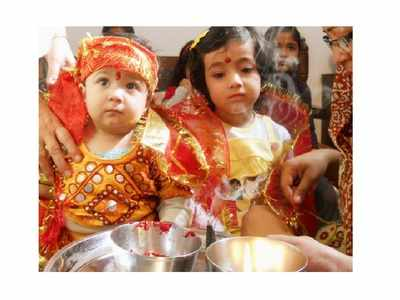As we celebrate Ashtami and Navami today, the air is filled with devotion, festivity, and joy. These two days mark the most significant part of Navratri—the culmination of nine days of prayers, fasting, and celebrations honoring the Goddess Durga. For those observing the festival, today is all about paying tribute to the divine feminine energy and seeking blessings for prosperity, happiness, and health.
In 2024, Ashtami and Navami fall on 11th October, making it a day of double significance as devotees across India come together for grand celebrations, pujas, and traditional rituals.
The Importance of Ashtami and Navami
Ashtami: The Worship of Goddess Mahagauri
Ashtami, or the eighth day of Navratri, is dedicated to Goddess Mahagauri, the epitome of purity, peace, and serenity. It is believed that worshipping Mahagauri on Ashtami washes away all sins and brings peace and prosperity into one’s life. This day is marked by special pujas, chanting of mantras, and fasting.
Many devotees perform the Kanya Puja, where nine young girls representing the nine forms of Goddess Durga are worshipped. These girls are offered traditional meals, gifts, and blessings as they are seen as manifestations of the goddess herself.
Navami: The Victory of Good Over Evil
Navami, the ninth day of Navratri, is dedicated to the goddess in her fierce form—Durga or Siddhidatri, the one who grants all desires and fulfills prayers. This day signifies the victory of good over evil, as Goddess Durga is believed to have defeated the demon Mahishasura.
Devotees observe Navami with great devotion, offering special prayers and performing rituals to seek the blessings of the goddess for success, happiness, and good fortune.
Traditional Celebrations on Ashtami and Navami
Kanya Puja: On Ashtami or Navami, many families perform Kanya Puja, where young girls are honored as forms of the goddess. They are given delicious food, usually including puri, chana, and halwa, and are offered gifts, sweets, and new clothes.
Sandhi Puja: Performed during the transition from Ashtami to Navami, this is one of the most significant rituals of Durga Puja. It is believed to be the exact time when Goddess Durga killed Mahishasura. Devotees perform this puja with great enthusiasm, often accompanied by lighting of lamps and offering 108 lotuses and 108 diyas.
Durga Balidan: On Navami, many people perform Durga Balidan, a symbolic sacrifice ritual. In modern times, instead of animal sacrifices, fruits, coconuts, and vegetables are offered to the goddess as a representation of devotion.
Dhunuchi Dance: In many parts of India, particularly in West Bengal, Dhunuchi Naach is a popular tradition where devotees perform a dance holding dhunuchis (clay lamps filled with incense and camphor). This is done as an offering to the goddess and adds a unique charm to the Navami celebrations.
Significance of Fasting and Prayers
Fasting is an integral part of Navratri, and today, on Ashtami and Navami, devotees often break their fast after performing puja. Fasting during Navratri is seen as a way to cleanse the body and mind, and to show devotion to Goddess Durga.
Many people choose to consume only sattvic foods such as fruits, milk, and grains during these days. The fast is often concluded with a feast prepared with great care, usually following the offerings made during the Kanya Puja.
How Ashtami and Navami are Celebrated Across India
West Bengal: Durga Puja in West Bengal reaches its peak on Ashtami and Navami. Pandals (temporary structures) are beautifully decorated, and the streets come alive with cultural performances, prayers, and offerings to the goddess. The energy and devotion during these days are palpable as thousands gather to seek blessings from Goddess Durga.
North India: In places like Delhi and Uttar Pradesh, devotees perform Kanya Puja and observe Ramlila, reenacting the story of Lord Rama and his victory over Ravana. Ashtami and Navami also see large gatherings for the burning of Ravana’s effigies, marking the upcoming celebration of Dussehra.
South India: In states like Tamil Nadu and Karnataka, the focus during Ashtami and Navami is on Ayudha Puja—the worship of tools and weapons, as a way to honor Goddess Saraswati and seek her blessings for wisdom and success. Many people also visit temples to perform special prayers and seek divine blessings.
Wishing You a Blessed Ashtami and Navami
As you celebrate these holy days, take a moment to reflect on the strength, courage, and wisdom that Goddess Durga embodies. The festival is a reminder of the power of good over evil and the importance of keeping faith during life’s challenges.
Here are a few Navratri Ashtami and Navami wishes to share with your loved ones:
- “May the divine blessings of Goddess Durga bring you happiness, success, and prosperity. Happy Ashtami and Navami 2024!”
- “Wishing you and your family a blessed Navami. May the goddess shower her love and grace upon you.”
- “On this auspicious occasion of Ashtami and Navami, may your life be filled with joy, peace, and good fortune.”
Conclusion
As we come together to celebrate the most significant days of Navratri—Ashtami and Navami—let’s honor the divine feminine energy that guides and protects us. Whether you’re observing the Kanya Puja, performing rituals, or simply reflecting on the deeper meaning of the festival, today is a day to rejoice, reflect, and be grateful.
May the goddess’s blessings light up your life, and may you have a joyful and prosperous Navratri 2024.
Happy Ashtami and Navami to all!







0 Comments